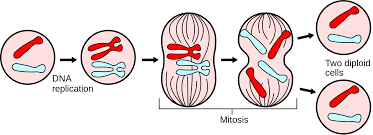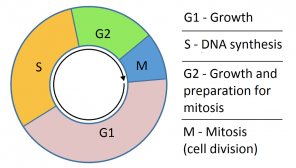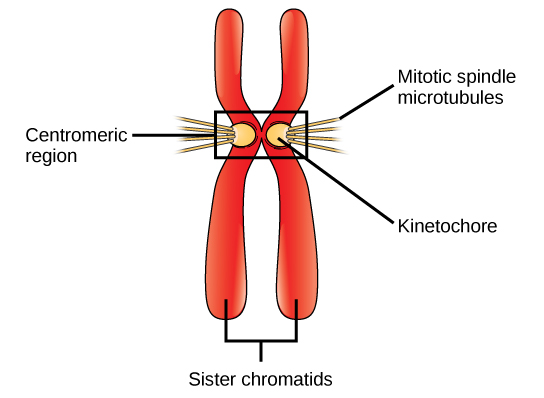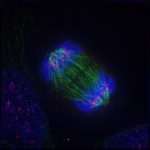
Mitosis
n., plural: mitoses
[maɪˈtoʊ.sɪs]
Definition: a process where cell divides, resulting in two identical cells
Table of Contents
Mitosis Definition
What is mitosis? In biology, mitosis refers to the cellular process where a single cell divides resulting in two identical cells. By identical, it means that both cells have the same number of chromosomes and genetic content. The mitosis steps include preprophase (in plant cells), prophase, prometaphase, metaphase, anaphase, and telophase. At which point each phase begins or ends is not clear as these phases apparently overlap. However, each of them is marked by distinctive events.
Originally, the term mitosis refers only to nuclear division unaccompanied by cytokinesis (which is the division of the cytoplasm), as in the case of some cells like certain fungi and in the fertilized eggs of many insects. Now, the term mitosis is used interchangeably with cell division. However, in the stricter sense, it is not always applicable as there is another form of cell division that involves the sex cells — the meiosis. The latter is distinctively different from mitosis.
Etymology: Greek mitos, meaning “warp thread” + –osis.
Synonyms: karyokinesis.
Mitosis vs. Meiosis
Mitosis is a form of cellular division that involves the somatic cells whereas meiosis is a cell division employed by the sex cells. The somatic cells divide mitotically to produce daughter cells that are genetically identical to the parent cell. In contrast, the sex cells divide by meiosis wherein the outcome is the production of cells that are genetically different from the original cell. In mitosis, the cell divides once whereas in meiosis the cell divides two times. Thus, a single cell results in two cells right after mitosis whereas a cell results in four cells after meiosis.
Other characteristics that define mitosis are as follows: genetic recombination does not happen during mitosis and the chromosome number is expected to be the same after mitosis; it is not reduced to half. These mitosis facts and info are depicted in the illustration below.

Cell Cycle Overview

The somatic cells of the eukaryotic body go through a sequence of biological events called the cell cycle. The cell cycle consists of these fundamental events: (1) resting phase (Gap 0), (2) interphase (Gap 1, S phase, Gap 2), and (3) cell division (i.e. mitotic phase and cytokinesis). In summary, the cell may enter either the resting phase or the interphase following cell division. If it enters the interphase, the cell would prepare itself for cell division by entering the S phase, where DNA replication occurs. After replication, the newly synthesized DNA molecules are checked and repaired if damaged. Prior to entering the mitotic phase, the cell has a control mechanism called G2-M DNA damage checkpoint that ensures the cell is ready for mitosis.
Stages of Mitosis
Where does mitosis occur? Mitosis happens in the somatic cells, particularly where the nucleus is at. During the early stages of mitosis (prophase), the nuclear envelope disintegrates, and thus, the subsequent stages of mitosis take place within the cell, occurring much in the cytoplasm.
The cell goes through a series of mitotic events that culminate in the formation of two identical daughter cells. The mitosis phases proceed in the following order of sequence: (1) prophase, (2) prometaphase, (3) metaphase, (4) anaphase, and (5) telophase. In plant cells, though, a preprophase occurs prior to prophase. In this article, 6 stages of mitosis are briefly explained.

Preprophase (plant cells)
Preprophase is a step in plant mitosis prior to prophase. During this phase, a preprophase band (a transient dense microtubule band) forms beneath the plasma membrane to mark the site of the plane of division and to set where the new cell wall will form during cytokinesis. The discovery of the importance of the preprophase band in plant mitosis was based on a study on Arabidopsis plant lacking the genetic capability to produce it. (Ref.1)
The start of microtubule nucleation at the nuclear envelope also occurs during preprophase. This is essential since plant cells do not have animal cell’s centrosomes. Centrosomes organize the mitotic spindles. In plants, the nuclear membrane (also called the nuclear envelope) serves as the microtubule-organizing center (MTOC).
Prophase
Prophase is the stage in mitosis where chromosomes, spindle, and polar bodies “appear“. From chromatin, the structure condenses into a chromosome. Remember that the result after S-phase is two copies of DNA in the form of two identical chains called sister chromatids. See the schematic diagram of a chromosome below.

Prometaphase
Prometaphase is the stage of mitosis in between prophase and metaphase. The major event is the disintegration of the nuclear envelope, forming many membrane vesicles. Because the nuclear envelope disintegrates, it seems to “disappear“. The same thing happens to the nucleolus; it disassembles. The disintegration of the nuclear envelope frees the chromosomes. Another important event at this stage is kinetochore formation in the centromere of the chromosome. Also, long protein filaments called kinetochore microtubules emerge from the centrosomes at the spindle pole on opposite ends of the cell. These microtubules, then, attach to the kinetochores of the chromosomes. (Ref.2)
Metaphase
In metaphase, the chromosomes continue to condense. The main highlight of this stage is the alignment of the chromosomes in the equatorial plane (or metaphase plate).
Anaphase
In anaphase, the two groups of daughter chromosomes separate and move along the fibers of the central spindle to opposite poles.
Telophase
In telophase, the chromosomes continue to move until two complete daughter nuclei are formed. The telophase is sometimes regarded as the opposite of prophase because the nucleolus and the nuclear membrane “reappear” as they reassemble on each daughter nuclei. The chromosomes de-condense into chromatin and the mitotic spindle disassembles, thus, apparently disappearing.
After this, cytokinesis begins. In some references, cytokinesis is a separate process whereas in others it is a part of telophase. However, the end of telophase marks the end of the mitotic phase of the cell cycle. In animal cells, cytokinesis is marked by a cleavage furrow formation whereas in plant cells, by a cell plate forming across the center of the cytoplasm (phragmoplast). The cell plate develops into a cell wall.
Regulation of Mitosis
Mitosis is a tightly regulated biological process. The major regulators of mitosis are a group of cyclins and Cyclin-Dependent Kinases (CDKs) that work together not just during the M phase but also in the various stages of the cell cycle.
- In Gap 1 (G1 phase), G1 cyclins activate CDKs. Activated CDKs, in turn, activate various proteins by phosphorylation to prepare the cell for the next stage.
- In Synthesis (S phase), cyclins and CDKs monitor the completion of DNA replication
- In Gap 2 (G2 phase), G2 cyclins activate CDKs to phosphorylate proteins that will initiate mitosis
- In Mitosis (M phase), M cyclins activate CDKs to initiate mitosis. CDKs control processes such as chromosome condensation, spindle formation, and the separation of sister chromatids during anaphase.
Note that there are checkpoints (e.g., G1 checkpoint, G2 checkpoint, and Metaphase checkpoint) that will verify if the conditions are favorable before proceeding to the next stage. Otherwise, the process will pause. The cell may enter a quiescent state (Gap 0) or undergo repairs first before proceeding.
Examples of unfavorable conditions or factors:
- G1:
- DNA damage or mutations
- Inadequate cell size
- Insufficient nutrients for DNA synthesis
- Lack of appropriate signals from signaling molecules
- G2:
- Incomplete DNA replication
- Errors in the DNA
- Insufficient resources (e.g., energy reserves) to support mitosis
- Metaphase of Mitosis:
- Improper attachment of chromosomes to spindle fibers
- Improper alignment of chromosomes along the metaphase plate
Mitosis Functions

What is the purpose of mitosis? Why is mitosis important? Mitosis is vital for living organisms to stay alive as it is involved in vital biological processes, particularly growth and tissue repair. Humans, for instance, rely on mitosis to produce the different cell types of the body. Without mitosis, we will have no body with intricate anatomy, to begin with. We will remain in the zygote stage as the zygote will not progress into a plethora of organized cells with distinctive roles.
In multicellular eukaryotes, the somatic cells undergo mitosis to form new cells essential for growth. When a tissue is injured, the cells divide to produce new cells that will replace lost cells. Some animals, such as starfish, have a high regeneration capacity. They can regenerate lost body parts, e.g. arms, through mitosis. Also, it could be a method to replenish normal yet worn-out cells of tissues and organs. Red blood cells, for instance, have a lifespan of only about 4 months. The body is replenished with new red blood cells by mitosis.
Other organisms use mitosis for asexual reproduction. Plants, for instance, reproduce through vegetative propagation, which basically incorporates mitosis in the process.
Forms of Mitosis
Mitosis may be “open”, “closed”, or “semi-open” based on the fate of the nuclear membrane during mitosis. Open mitosis is one wherein the nuclear envelope disassembles, thereby, freeing the chromosomes. This is seen in animal and plant cells. Closed mitosis is when the nuclear envelope persists. This is observed in fungi, certain protists, and many algae. Their chromosomes divide within an intact nucleus. (Ref. 3) A semi-open is the intermediate form and occurs in most Apicomplexa.
Prokaryotes do not have mitosis. However, their method of asexual reproduction is similar to the process of mitosis. Referred to as binary fission, the bacterial cell divides into two, which are clones of the original cell.
Mitosis Examples
In multicellular eukaryotes, stem cells are the type of cells that have not acquired a specific function yet. Instead, they divide indefinitely to produce more cells. In medicine and research, scientists culture them for use in stem cell treatments. Apart from stem cells, other mitotically active cells are progenitor cells and blast cells (precursors). Both of them divide but not as indefinitely as the stem cells. Cancer cells are another example. They are originally normal cells that eventually have lost control over their cell division and thus continue to proliferate.
Try to answer the quiz below to check what you have learned so far about mitosis.
References
- Schaefer, E., Belcram, K., Uyttewaal, M., Duroc, Y., Goussot, M., Legland, D., Laruelle, E., de Tauzia-Moreau, M.-L., Pastuglia, M., & Bouchez, D. (2017). The preprophase band of microtubules controls the robustness of division orientation in plants. Science, 356(6334), 186–189. https://doi.org/10.1126/science.aal3016
- prometaphase | Learn Science at Scitable. (2014). Nature.Com. https://www.nature.com/scitable/definition/prometaphase-281/
- De Souza, C. P. C., & Osmani, S. A. (2007). Mitosis, Not Just Open or Closed. Eukaryotic Cell, 6(9), 1521–1527. https://doi.org/10.1128/ec.00178-07
©BiologyOnline. Content provided and moderated by BiologyOnline Editors.








